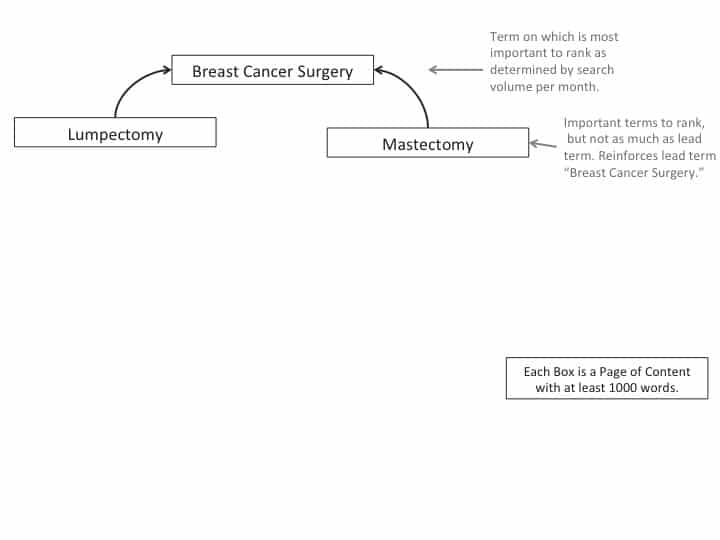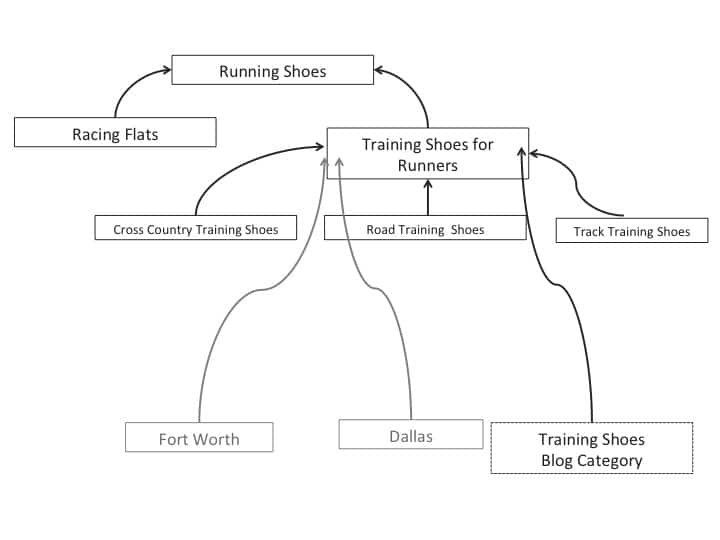You know you need to rank on certain keywords in order for potential customer to find you online.
Did you know the way your site is structured can tell Google which of all the words on your site is most important to rank?
Sometimes called site hierarchy, we call it siloing (site silos, a siloed site, or SEO silo structure).
It’s a pre-design SEO strategy we use in your web design that sets us apart from most other web designers.
Very few web design firms are thinking at this level of site development before they ever launch your project. Most rush to colors and fonts when they should be doing the deep dive of deciding on the structure of the site that is friendly to the end-user and that communicates the site’s intent to search engines.
Enter The Website Silo
There a lot of words and phrases on each page of your website. Search engines try to make sense of these words in order to determine what is the main point of a given page.
You might mention the word “diamond” on a page, but that word can mean many things.
If Google sees the word “shiny” on the page, it will lean towards understanding the word as a gemstone. Add the word “engagement ring” and “clarity” to the page and now Google better understands the term really means a diamond gemstone.
If Google sees the word “mound” or “ball and glove” on the page, it realizes you are most likely talking about a baseball diamond.
That is easy to understand at the page level of your site.
But what if we start using that concept at the structural level of your site? There is an incredible power in doing this.
What is a Site Silo?
One of the definitions of a silo is a tower or pit on a farm used to store grain.
Note that a silo holds a single type of grain. You don’t mix wheat and corn in a silo. It contains a single type of grain.

Another definition of silo is a verb, meaning to isolate (one system, process, department, etc.) from others.
The same thing is true of your website. You need silos that each hold a single category or type of information about your business.
When your site is siloed, Google and other search engines are able to determine, “Oh, this silo is about X and that silo is about Y.” It reduces ambiguity.
Then the search engine starts ranking those silos.
This example will make it easy to understand.
Let’s Build a SEO Site Silo Together: An Example
Suppose you are a breast cancer surgeon who practices in the DFW area. You are a great surgeon and want patients in the area to be able to find you as an option for treatment.
The first thing we’d do is to gather all the keywords on which you probably need to rank.
Some of these would include “breast cancer surgery,” “mastectomy,” “lumpectomy,” “full mastectomy” “recovery after breast cancer surgery,” “full mastectomy” “partial mastectomy” etc.
The next step to building a great silo is to determine the number of searches each term gets per month in your region. We have the tools to accomplish this.
We also pull the number of results that occur for that particular keyword. The more results, the more difficult the term is to rank.
We push this into an equation and determine the hierarchy of the terms that are inter-related.
Here is the first level of the silo. In this case, “breast cancer surgery” has far more monthly search volume than any other term related to the topic.
We want this key term to be the top or head of the silo.

It WILL be a challenge to rank “breast cancer surgery” because of the large number of search results, but over time, we can rank it for the region in which your practice resides.
We are reinforcing the “breast cancer surgery” page with two more full-length pages, which in this case are types of breast cancer surgery.
There are two major types of surgery: mastectomy and lumpectomy.
We create full sub-pages for each of these which point back to the main “breast cancer surgery” landing page.

We then add in the sub-sub-pages, which reinforce the sub-pages, which reinforce the main landing page: Partial mastectomy, Hidden Scar Surgery, etc.
One good thing about these sub-sub-pages is that they can typically start ranking more quickly because there is less competition as measured by the number of competing results.

Now our topical breadth and topical depth (how much quality content is under silo lead page) is getting dense. The search engines love this.
But we aren’t done yet.
Geo-Locating Your Silo
Now we tie the silo to a city or region. In this case, we can create a Dallas page and a Fort Worth page. We can keep going on surrounding cities. This lets the search engine know where we provide service.

Search engines have started giving prominence in the results to entities which are close to the searcher. We can show the search engines this through an address and great content pages about the areas you serve.
Adding Icing to the SEO Silo Cake
People search for a lot of related terms like “how long is breast cancer surgery recovery?” and other phrases and questions. These are perfect blog article titles.
By titling the blog category with the exact same name as the lead silo term we are attempting to rank, all the SEO power from each article gets funneled to the main silo landing page (breast cancer surgery, in this case).

Many times these blogs will rank as the answer to a question people search. In addition, they are passing SEO juice up to the main landing page when we properly set up the site navigation and interlink the pages.
The set-up and interlinking are deceptively complicated.
We don’t want the silo to “bleed” into other silos on the site. The wheat doesn’t need to mix with the corn. If it does, the search engines get confused.
We put special tactical items in place to make this happen.
And just to show you the exact same concept can work with a retail or e-commerce site, check out this running shoe example where we fleshed out one half of the silo for you to see.

Now We are Rolling
Once you get a great silo structure on your site, it makes the off-page search engine efforts that much easier.
It takes much less off-page SEO work–doing things like healthy link building–if your page is tightly siloed.
We are your siloing experts.
Each Moon & Owl website design is meticulously researched before we ever start selecting the color, fonts and look of your site.
A beautiful site that can’t be found doesn’t do you much good. You need your site to help grow your business, organization or practice.
Get beauty and functionality and have your own online conversion machine with a website and search engine optimization by Moon & Owl!
Update: See the new Tensile Silo we are testing.
